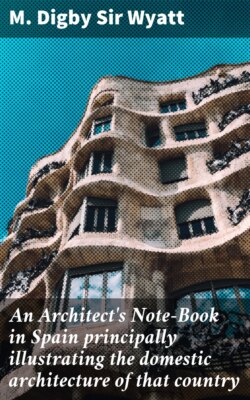Читать книгу An Architect's Note-Book in Spain principally illustrating the domestic architecture of that country - Sir M. Digby Wyatt - Страница 22
На сайте Литреса книга снята с продажи.
LEON. CONVENT OF SAN MARCOS.
ОглавлениеON the 3rd of September, 1512, a meeting took place between certain ecclesiastics of the Chapter of Salamanca, and nine of the most famous architects of Spain, the minute or "procès verbal" of which would form a model for what might often be done in this country with much advantage to all concerned in the initiation of any great architectural work. The object of the Junta was to settle the principal difficulties of the design of the new Cathedral of Salamanca, then about to be begun. Interesting as are all the conclusions arrived at upon this memorable occasion, it is not with them we have now to concern ourselves, but with the circumstance only that, amongst the signatures attached to the document[7] occurs that of Juan de Badajoz, the architect of the noble façade of the celebrated Convent of the Knights of Santiago at Leon, which forms the subject of our ninth sketch. In the following year to that of the meeting at Salamanca, Juan de Badajoz was summoned in concert with Juan Gil de Hontañon and Juan de Alava to report on the repairs necessary to the Cathedral at Seville. For this he was paid by the Chapter one hundred ducats, no mean sum in those days. Called from Seville to Leon, Badajoz seems to have immediately set in hand the Capilla Mayor of the Church of San Isidro. In Leon and elsewhere he appears to have been much employed, until in 1537 he commenced the Convent of San Zoil at Carrion (about twelve leagues from Leon,) for the Condes of that place. The taste for elaborate ornamental sculpture greatly increasing at that time, Juan de Badajoz seems to have taken pains to surround himself with the most skilful carvers of his days, and on all occasions to have pushed them forwards as their merits deserved. Hence, when called upon, shortly after setting in hand the works at Carrion, to commence the even more elaborate and important ones of San Marcos, he was able to carry on the two for a time concurrently, and ultimately to resign the charge of what he began and advanced considerably single-handed at Leon, to his deputy, Pedro di Castrillo.
On San Marcos, Juan de Badajoz appears to have worked pertinaciously, at any rate until the year 1543, when more than half the whole work was completed. In the sculpture, of which there is an enormous quantity, he had the assistance, as principal sculptor, of Guillermo Doncel. The ornamental details[8] are excellent, far better than those involving a knowledge of the proportions and forms of the human figure. The size of the building is enormous, and its general effect very picturesque. The works appear to have been suspended while still far from complete. They were not resumed until the year 1715.
